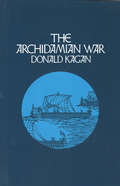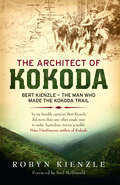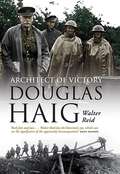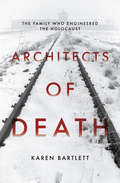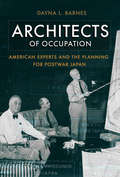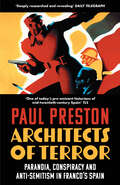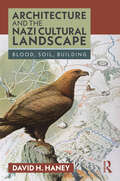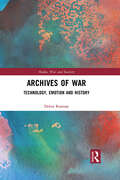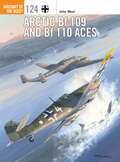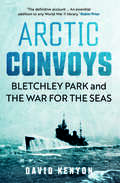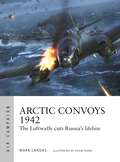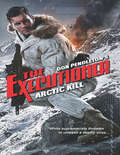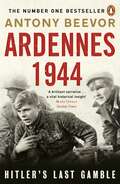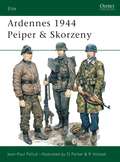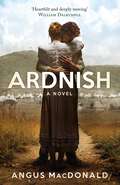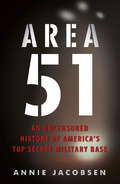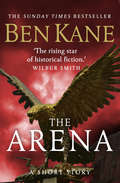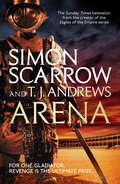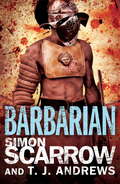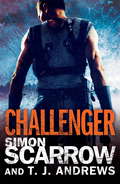- Table View
- List View
The Archidamian War
by Donald KaganThis book, the second volume in Donald Kagan's tetralogy about the Peloponnesian War, is a provocative and tightly argued history of the first ten years of the war. Taking a chronological approach that allows him to present at each stage the choices that were open to both sides in the conflict, Kagan focuses on political, economic, diplomatic, and military developments. He evaluates the strategies used by both sides and reconsiders the roles played by several key individuals.
The Architect of Kokoda: Bert Kienzle - the man who made the Kokoda track (Hachette Military Collec Ser.)
by Robyn KienzleIn my humble opinion, Bert Kienzle did more than any other single man to make Australian victory possible.' Peter FitzSimons, author of KokodaIn 1942, when the Japanese had invaded Papua New Guinea and the Australian soldiers sent to hold them back thought victory was impossible, one man, Bert Kienzle, changed the course of history.This charismatic man, well known in Papua for having run gold mines and plantations there, was charged with the seemingly impossible task of establishing a trail across the forbidding Owen Stanley Range in just a few short months.Out of jungle and mud, Kienzle carved a working transport route that his handpicked teams of native bearers, the now famous Fuzzy Wuzzy Angels, would work on alongside the Australian troops ensuring that the men got the food, munitions and medical support they needed. The feats that these men performed were heroic, and their endurance as they transported supplies along the Trail unparalleled. Bert Kienzle lived an amazing life and the transport route he established – the legendary Kokoda Trail – made Australia’s victory possible.This is his story.
Architect of Victory: Douglas Haig
by Walter ReidA thoughtful reassessment' - Stand To! 'Sharp and clear...swift and surefooted' - The Scotsman 'A careful biographer' - Times Literary Supplement 'Those new to the Haig debate will receive a good introduction. Those already familiar with the subject matter will enjoy Reid's writing style and reflective moments' - The British Army Review 'An outstanding success. The argument is beautifully presented and written in very clear English. This is a substantial work which follows the rules of classical biography' - Politique étrangère Douglas Haig's popular image as an unimaginative butcher is unenviable and unmerited. In fact, he masterminded a British-led victory over a continental opponent on a scale that has never been matched before or since. Contrary to myth, Haig was not a cavalry-obsessed, blinkered conservative, as satirised in Oh! What a Lovely War and Blackadder Goes Forth. Fascinated by technology, he pressed for the use of tanks, enthusiastically embraced air power, and encouraged the use of new techniques involving artillery and machine-guns. Above all, he presided over a change in infantry tactics from almost total reliance on the rifle towards all-arms, multi-weapons techniques that formed the basis of British army tactics until the 1970s. Prior re-evaluations of Haig's achievements have largely been limited to monographs and specialist writings. Walter Reid has written the first biography of Haig that takes into account modern military scholarship, giving a more rounded picture of the private man than has previously been available. What emerges is a picture of a comprehensible human being, not necessarily particularly likeable, but honourably ambitious, able and intelligent, and the man more than any other responsible for delivering victory in 1918.
Architects of Death: The Family Who Engineered the Holocaust
by Karen BartlettTopf and Sons designed and built the crematoria at the concentration camps at Auschwitz-Birkenau, Buchenwald, Belzec, Dachau, Mauthausen and Gusen. At its height sixty-six Topf triple muffle ovens were in operation – forty-six of which were at Auschwitz.In five years the gas chambers and crematoria of Auschwitz had been the engine of the holocaust, facilitating the murder and incineration of more than one million people, most of them Jews.Yet such a spectacularly evil feat of engineering was designed not by the Nazi SS, but by a small respectable firm of German engineers: the owners and engineers of J. A. Topf and Sons. These were not Nazi sadists, but men who were playboys and the sons of train drivers. They were driven not by ideology, but by love affairs, personal ambition and bitter personal rivalries to create the ultimate human killing and disposal machines – even at the same time as their company sheltered Nazi enemies from the death camps.The intense conflagration of their very ordinary motives created work that surpassed in its inhumanity even the demands of the SS. In order to fulfil their own ‘dreams’ they created the ultimate human nightmare.
Architects of Occupation: American Experts and Planning for Postwar Japan
by Dayna L. BarnesThe Allied occupation of Japan is remembered as the "good occupation." An American-led coalition successfully turned a militaristic enemy into a stable and democratic ally. Of course, the story was more complicated, but the occupation did forge one of the most enduring relationships in the postwar world. Recent events, from the occupations of Iraq and Afghanistan to protests over American bases in Japan to increasingly aggressive territorial disputes between Asian nations over islands in the Pacific, have brought attention back to the subject of the occupation of Japan.In Architects of Occupation, Dayna L. Barnes exposes the wartime origins of occupation policy and broader plans for postwar Japan. She considers the role of presidents, bureaucrats, think tanks, the media, and Congress in policymaking. Members of these elite groups came together in an informal policy network that shaped planning. Rather than relying solely on government reports and records to understand policymaking, Barnes also uses letters, memoirs, diaries, and manuscripts written by policymakers to trace the rise and spread of ideas across the policy network. The book contributes a new facet to the substantial literature on the occupation, serves as a case study in foreign policy analysis, and tells a surprising new story about World War II.
Architects of Terror: Paranoia, Conspiracy And Anti-semitism In Franco's Spain
by Paul PrestonA TIMES HISTORY BOOK OF THE YEAR From the preeminent historian of 20th century Spain Paul Preston, Architects of Terror is a new history of how paranoia, conspiracy and anti-Semitism was used to justify the military coup of 1936 and enabled the construction of a dictatorship built on violence and persecution.
Architecture and the Nazi Cultural Landscape: Blood, Soil, Building
by David H. HaneyThis book traces cultural landscape as the manifestation of the state and national community under the Nazi regime, and how the Nazi era produced what could be referred to as a totalitarian cultural landscape.For the Nazi regime, cultural landscape was indeed a heritage resource, but it was much more than that: cultural landscape was the nation. The project of Nazi racial purification and cultural renewal demanded the physical reshaping and reconceptualization of the existing environment to create the so-called "new Nazi cultural landscape." One of the most important components of this was a set of monumental sites thought to embody blood and soil beliefs through the harmonious synthesis of architecture and landscape. This special group of "landscape-bound" architectural complexes was interconnected by the new autobahn highway system, itself thought to be a monumental work embedded in nature. Behind this intentionally aestheticized view of the nation as cultural landscape lay the all-pervasive system of deception and violence that characterized the emerging totalitarian state.This is the first historical study to consider the importance of these monumental sites together with the autobahn as evidence of key Nazi cultural and geographic strategies during the pre-war years. This book concludes by examining racial and nationalistic themes underlying cultural landscape concepts today, against this historic background.
Architecture and the Nazi Cultural Landscape: Blood, Soil, Building
by David H. HaneyThis book traces cultural landscape as the manifestation of the state and national community under the Nazi regime, and how the Nazi era produced what could be referred to as a totalitarian cultural landscape.For the Nazi regime, cultural landscape was indeed a heritage resource, but it was much more than that: cultural landscape was the nation. The project of Nazi racial purification and cultural renewal demanded the physical reshaping and reconceptualization of the existing environment to create the so-called "new Nazi cultural landscape." One of the most important components of this was a set of monumental sites thought to embody blood and soil beliefs through the harmonious synthesis of architecture and landscape. This special group of "landscape-bound" architectural complexes was interconnected by the new autobahn highway system, itself thought to be a monumental work embedded in nature. Behind this intentionally aestheticized view of the nation as cultural landscape lay the all-pervasive system of deception and violence that characterized the emerging totalitarian state.This is the first historical study to consider the importance of these monumental sites together with the autobahn as evidence of key Nazi cultural and geographic strategies during the pre-war years. This book concludes by examining racial and nationalistic themes underlying cultural landscape concepts today, against this historic background.
Archives of War: Technology, Emotion and History (Media, War and Security)
by Debra RamsayThis book offers a comparative analysis of British Army Unit War Diaries in the two World Wars, to reveal the role played by previously unnoticed technologies in shaping the archival records of war. Despite thriving scholarship on the history of war, the history of Operational Record Keeping in the British Army remains unexplored. Since World War I, the British Army has maintained daily records of its operations. These records, Unit War Diaries, are the first official draft of events on the battlefield. They are vital for the army’s operational effectiveness and fundamental to the histories of British conflict, yet the material history of their own production and development has been widely ignored. This book is the first to consider Unit War Diaries as mediated, material artefacts with their own history. Through a unique comparative analysis of the Unit War Diaries of the First and Second World Wars, this book uncovers the mediated processes involved in the practice of operational reporting and reveals how hidden technologies and ideologies have shaped the official record of warfare. Tracking the records into The National Archives in Kew, where they are now held, the book interrogates how they are re-presented and re-interpreted through the archive. It investigates how the individuals, institutions and technologies involved in the production and uses of unit diaries from battlefield to archive have influenced how modern war is understood and, more importantly, waged. This book will be of much interest to students of media and communication studies, military history, archive studies and British history.
Archives of War: Technology, Emotion and History (Media, War and Security)
by Debra RamsayThis book offers a comparative analysis of British Army Unit War Diaries in the two World Wars, to reveal the role played by previously unnoticed technologies in shaping the archival records of war. Despite thriving scholarship on the history of war, the history of Operational Record Keeping in the British Army remains unexplored. Since World War I, the British Army has maintained daily records of its operations. These records, Unit War Diaries, are the first official draft of events on the battlefield. They are vital for the army’s operational effectiveness and fundamental to the histories of British conflict, yet the material history of their own production and development has been widely ignored. This book is the first to consider Unit War Diaries as mediated, material artefacts with their own history. Through a unique comparative analysis of the Unit War Diaries of the First and Second World Wars, this book uncovers the mediated processes involved in the practice of operational reporting and reveals how hidden technologies and ideologies have shaped the official record of warfare. Tracking the records into The National Archives in Kew, where they are now held, the book interrogates how they are re-presented and re-interpreted through the archive. It investigates how the individuals, institutions and technologies involved in the production and uses of unit diaries from battlefield to archive have influenced how modern war is understood and, more importantly, waged. This book will be of much interest to students of media and communication studies, military history, archive studies and British history.
Arctic Bf 109 and Bf 110 Aces (Aircraft of the Aces #124)
by John WealOnce Nazi Germany had conquered Norway in 1940, just a handful of Gruppen flying the Bf 109 and Bf 110 fighters were able to shatter all opposition and dominate the air in the Arctic Circle. Yet as the dual threats of the RAF and the Red Air Force grew, the Luftwaffe was forced to increase its fighter presence to full Geschwader strength with the formation of JG 5 Eismeer (Ice-sea) in early 1942.The struggle for the frozen skies of the arctic raged on until the end of the war as the embattled JG 5 produced some of the Eastern Front's leading aces, pilots of the calibre of Theodor Weissenberger, Heinrich Ehrler, Walter Schuck, Franz Dörr and Jakob Norz all achieving over 100 kills. Featuring first-hand accounts from the pilots, extensive research from a leading authority on the Luftwaffe, and illustrations of the aircraft in unique winter camouflage, this book is a comprehensive guide to the Arctic Experten and the planes they flew.
Arctic Bf 109 and Bf 110 Aces (Aircraft of the Aces)
by John Weal Chris Davey Mark PostlethwaiteOnce Nazi Germany had conquered Norway in 1940, just a handful of Gruppen flying the Bf 109 and Bf 110 fighters were able to shatter all opposition and dominate the air in the Arctic Circle. Yet as the dual threats of the RAF and the Red Air Force grew, the Luftwaffe was forced to increase its fighter presence to full Geschwader strength with the formation of JG 5 Eismeer (Ice-sea) in early 1942.The struggle for the frozen skies of the arctic raged on until the end of the war as the embattled JG 5 produced some of the Eastern Front's leading aces, pilots of the calibre of Theodor Weissenberger, Heinrich Ehrler, Walter Schuck, Franz Dörr and Jakob Norz all achieving over 100 kills. Featuring first-hand accounts from the pilots, extensive research from a leading authority on the Luftwaffe, and illustrations of the aircraft in unique winter camouflage, this book is a comprehensive guide to the Arctic Experten and the planes they flew.
Arctic Convoys: Bletchley Park and the War for the Seas
by David KenyonAn incisive account of the Arctic convoys, and the essential role Bletchley Park and Special Intelligence played in Allied success Between 1941 and 1945, more than eight hundred shiploads of supplies were delivered to the Soviet Union protected by allied naval forces. Each journey was a battle against the elements, with turbulent seas, extreme cold, and the constant dread of torpedoes. These Arctic convoys have been mythologized as defenseless vessels at the mercy of deadly U-boats—but was this really the case? David Kenyon explores the story of the war in the Arctic, revealing that the contest was more evenly balanced that previously thought. Battles included major ship engagements, aircraft carriers, and combat between surface ships. Amid this wide range of forces, Bletchley Park’s Naval Section played a decisive role in Arctic operations, with both sides relying heavily on Signals Intelligence to intercept and break each other’s codes. Kenyon presents a vivid picture of the Arctic theater of war, unearthing the full-scale campaign for naval supremacy in northern waters.
Arctic Convoys 1942: The Luftwaffe cuts Russia's lifeline (Air Campaign)
by Mark LardasA new history of the most crucial few months of the Arctic Convoys, when Germany's air power forced the Allies to retreat to the cover of winter. Between spring and autumn 1942, Germany was winning the battle of the Arctic Convoys. Half of PQ-15 was sunk in May, PQ-17 was virtually obliterated in July, and in September 30 percent of PQ-18 was sunk. The Allies were forced to suspend the convoys until December, when the long Arctic nights would shield them.Mark Lardas argues that in 1942, it was Luftwaffe air power that made the difference. With convoys sailing in endless daylight, German strike aircraft now equipped and trained for torpedo attacks, and bases in northern Norway available, the Luftwaffe could wreak havoc. Three-quarters of the losses of PQ-18 were due to air attacks. But in November, the Luftwaffe was redeployed south to challenge the Allied landings in North Africa, and the advantage was lost. Despite that, the Allies never again sailed an Arctic convoy in the summer months.Fully illustrated with archive photos, striking new artwork, maps and diagrams, this is the remarkable history of the Luftwaffe's last strategic victory of World War II.
Arctic Convoys 1942: The Luftwaffe cuts Russia's lifeline (Air Campaign)
by Mark LardasA new history of the most crucial few months of the Arctic Convoys, when Germany's air power forced the Allies to retreat to the cover of winter. Between spring and autumn 1942, Germany was winning the battle of the Arctic Convoys. Half of PQ-15 was sunk in May, PQ-17 was virtually obliterated in July, and in September 30 percent of PQ-18 was sunk. The Allies were forced to suspend the convoys until December, when the long Arctic nights would shield them.Mark Lardas argues that in 1942, it was Luftwaffe air power that made the difference. With convoys sailing in endless daylight, German strike aircraft now equipped and trained for torpedo attacks, and bases in northern Norway available, the Luftwaffe could wreak havoc. Three-quarters of the losses of PQ-18 were due to air attacks. But in November, the Luftwaffe was redeployed south to challenge the Allied landings in North Africa, and the advantage was lost. Despite that, the Allies never again sailed an Arctic convoy in the summer months.Fully illustrated with archive photos, striking new artwork, maps and diagrams, this is the remarkable history of the Luftwaffe's last strategic victory of World War II.
Ardennes 1944: Hitler's Last Gamble
by Antony BeevorFrom the bestselling author of Stalingrad, Berlin and D-Day, Antony Beevor's Ardennes 1944: Hitler's Last Gamble tells the story of the German's ill-fated final stand.On 16 December, 1944, Hitler launched his 'last gamble' in the snow-covered forests and gorges of the Ardennes. He believed he could split the Allies by driving all the way to Antwerp, then force the Canadians and the British out of the war. Although his generals were doubtful of success, younger officers and NCOs were desperate to believe that their homes and families could be saved from the vengeful Red Army approaching from the east. Many were exultant at the prospect of striking back. The Ardennes offensive, with more than a million men involved, became the greatest battle of the war in western Europe. American troops, taken by surprise, found themselves fighting two panzer armies. Belgian civilians fled, justifiably afraid of German revenge. Panic spread even to Paris. While many American soldiers fled or surrendered, others held on heroically, creating breakwaters which slowed the German advance. The harsh winter conditions and the savagery of the battle became comparable to the eastern front. And after massacres by the Waffen-SS, even American generals approved when their men shot down surrendering Germans. The Ardennes was the battle which finally broke the back of the Wehrmacht.'Revealing, profound and thoroughly unputdownable, Stalingrad is an extraordinary achievement which transcends its genre' Vitali Vitaliev, Daily Telegraph (on Stalingrad)'This brilliant storyteller. . . makes us feel the chaos and the fear as if every drop of blood was our own: that is his gift. It is much more than just a humane account; it is compellingly readable, deeply researched and beautifully written' Simon Sebag Montefiore, Spectator (on Berlin)'This is a terrific, inspiring, heart-breaking book. It makes the argument all over again that the world would be an infinitely better place if it didn't keep producing subject matter for military historians: but as long as it does, we can rejoice that at the top of that profession is Antony Beevor' Sam Leith, Daily Mail (on D-Day)'His book is the definitive history. This is World War II as Tolstoy would have described it - the great and the small' Gerard DeGroot, Washington Post (on The Second World War)Antony Beevor is the renowned author of Stalingrad, which won the Samuel Johnson Prize, the Wolfson Prize for History and the Hawthornden Prize for Literature, and Berlin, which received the first Longman-History Today Trustees' Award. His books have appeared in thirty foreign editions and sold over six million copies.
Ardennes 1944 Peiper & Skorzeny (Elite)
by David Parker Jean-Paul PalludFrom the earliest planning stages of the German counter-offensive in the Ardennes, Hitler was convinced of the importance of taking the Meuse bridges. He resolved that, when his forces broke through the US lines, one special unit should be dressed in American uniforms and issued with American weapons and vehicles. In this guise they could take advantage of the surprise and shock of the breakthrough, and move forward to the Meuse bridges as if they were retreating Americans. Jean-Paul Pallud details their organisation and the fateful sequence of events that followed.
Ardennes 1944 Peiper & Skorzeny (Elite #11)
by David Parker Jean-Paul PalludFrom the earliest planning stages of the German counter-offensive in the Ardennes, Hitler was convinced of the importance of taking the Meuse bridges. He resolved that, when his forces broke through the US lines, one special unit should be dressed in American uniforms and issued with American weapons and vehicles. In this guise they could take advantage of the surprise and shock of the breakthrough, and move forward to the Meuse bridges as if they were retreating Americans. Jean-Paul Pallud details their organisation and the fateful sequence of events that followed.
Ardnish: A Novel (The\ardnish Ser. #2)
by Angus MacDonaldPraise for the Ardnish Series'What I really enjoyed about this book was its beauty, an enthralling read that is both brutal and poetic' – Daily Record‘A fast-paced narrative with deeply likeable characters ... far more than yet another wartime love story ... impossible to put down’ – Scottish Field, Book of the Month‘Not only a gripping and at times horrifying adventure . . . it is also an important piece of social history. But perhaps above all, it is a tale of the importance of true love and determination’ – Scots MagazineArdnish, the Highlands of Scotland, 1944. On his deathbed, Donald John Gillies sends for a priest to hear his last confession. During his 85 years he has witnessed much – world wars, the loss of family through death and emigration, and the daily struggles which face the small remote community.Waiting anxiously for the priest, his mind travels back to the dusty plains of South Africa in 1901, where he fought as a Lovat Scout during the Boer War, and where he met the woman who was the love of his life. Forced to abandon her and her young daughter in a British concentration camp, DJ returns to Scotland and his old life after his camp is ambushed by Boers and many of his fellow soldiers are massacred.As he lies dying, an unexpected visitor arrives at Ardnish. making it more imperative then ever for DJ to come to terms with the past and to make peace with himself – and his family – while there is still time.
Area 51: An Uncensored History of America's Top Secret Military Base
by Annie JacobsenThe explosive, untold story of the Cold War's biggest secret. The REAL X-Files.It is the most famous military installation in the world. And no credible insider has ever divulged the truth about his time inside of it. Until now. This is the first book based on interviews with scientists, pilots, and engineers - 58 in total - who provide an unprecedented look into the mysterious activities of a top-secret base, from the Cold War to today. With a jaw-dropping ending, it proves that facts are often more fantastic than fiction, especially when the distinction is almost impossible to make.
The Arena (Eagles of Rome)
by Ben KaneAn exclusive digital short from Ben Kane, ‘the rising star of historical fiction’ (Wilbur Smith). A day out with comrades, brutal gladiator fights, a bet with disastrous consequences. A Roman soldier’s much anticipated payday plays out in very different ways to those he expected.The German frontier, AD 12. Legionary Marcus Piso is set to enjoy a four monthly payday with his comrades. Wine, food and gladiatorial entertainment are on offer, and his purse is full.But thanks to a dishonest bet maker, events take on a very dangerous life of their own...The Arena is a prequel to Ben Kane's upcoming novel, Hunting the Eagles, the second in the new gripping three-part series, Eagles of Rome. It also includes a sample chapter from the new book.
Arena
by Simon Scarrow T. J. AndrewsARENA is a Sunday Times bestselling novel from Simon Scarrow, author of CENTURION, THE GLADIATOR and BRITANNIA, and T.J. Andrews. Perfect for fans of Bernard Cornwell.It is AD 41. The city of Rome is a dangerous place. Optio Macro of the Second Legion, recently decorated for courage on the battlefield, can't wait to leave the teeming city behind. He's dismayed when he's compelled to stay in Rome to train Marcus Valerius Pavo, a young gladiatorial recruit. Though fearless Pavo has fought for his life before, he's a novice in the arena. But he's a driven man, with a goal dearer than survival - to avenge his father's death at the hands of a champion gladiator. Will he live to face his nemesis?ARENA has previously been published as five separate ebook novellas. This edition brings the complete series together.
Arena: Barbarian (Roman Arena #1)
by Simon Scarrow T. J. AndrewsThe first in a series of action-packed novellas set in Ancient Rome introducing Pavo, a novice gladiator, and featuring Simon Scarrow's ongoing soldier character Optio Macro.It is AD 41. The savage Gaul Britomaris has defeated the best of the Roman gladiators in the arena. Now a young volunteer, Marcus Valerius Pavo, the son of a murdered general, has been given a month to prepare to face Britomaris in a fight which only one man can survive. He is to be trained by veteran soldier Macro, who fears for his young trainee's chances. But Pavo is motivated by more than a simple desire for victory or survival, and Britomaris may yet be facing his most dangerous opponent...
Arena: Challenger (Roman Arena #2)
by Simon Scarrow T. J. AndrewsThe second novella in Simon Scarrow's Roman Arena series, following novice gladiator Pavo's next gruelling test, which will put mentor Macro's loyalties on the line.Rome under the rule of the ruthless new Emperor Claudius is a dangerous place. Condemned to gladiator school Marcus Valerius Pavo, the son of a treasonous general, is a celebrated hero following a dramatic victory in the arena. Now he finds himself pitted against one of the greatest gladiators who ever lived: Decimus Cominius Denter. Though Denter has fallen on harder times he is still a formidable opponent, and it is up to newly decorated Macro to whip him into shape. But as the much-heralded fight descends into chaos and riots threaten to engulf the city, Macro must choose between his duty to Rome and his loyalty to Pavo...
